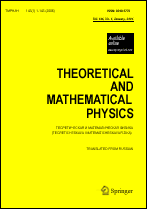|
This article is cited in 2 scientific papers (total in 2 papers)
Solutions of the analogues of time-dependent Schrödinger equations corresponding to a pair of $H^{3+2}$ Hamiltonian systems
V. A. Pavlenko
Institute of Mathematics with Computer Center,
Ufa Science Center, Russian Academy of Sciences, Ufa, Russia
Abstract:
We construct joint $2\times2$ matrix solutions of the scalar linear evolution equations $\Psi'_{s_k}=H^{3+2}_{s_k}(s_1,s_2,[0]x_1,x_2, \partial/\partial x_1,\partial/\partial x_2)\Psi$ with times $s_1$ and $s_2$, which can be treated as analogues of the time-dependent Schrödinger equations. These equations correspond to the so-called $H^{3+2}$ Hamiltonian system, which is a representative of a hierarchy of degenerations of the isomonodromic Garnier system described by Kimura in 1986. This compatible system of Hamiltonian ordinary differential equations is defined by two different Hamiltonians $H^{3+2}_{s_k}(s_1,s_2,q_1,q_2,p_1,p_2)$, $k=1,2$, with two degrees of freedom corresponding to the time variables $s_1$ and $s_2$. In terms of solutions of the linear systems of ordinary differential equations obtained by the isomonodromic deformation method, with the compatibility condition given by the Hamilton equations of the $H^{3+2}$ system, the constructed compatible solutions of analogues of the time-dependent Schrödinger equations are presented explicitly. We also present a change of variables relating the matrix solutions of analogues of the time-dependent Schrödinger equations defined by two forms of the $H^{3+2}$ system (rational and polynomial in coordinates). This system is a quantum analogue of the well-known canonical transformation relating the Hamilton equations of the $H^{3+2}$ system in these two forms.
Keywords:
Hamiltonian systems, Painlevé-type equations, time-dependent Schrödinger equations, isomonodromic deformation method.
Received: 12.03.2022
Revised: 06.05.2022
Citation:
V. A. Pavlenko, “Solutions of the analogues of time-dependent Schrödinger equations corresponding to a pair of $H^{3+2}$ Hamiltonian systems”, TMF, 212:3 (2022), 340–353; Theoret. and Math. Phys., 212:3 (2022), 1181–1192
Linking options:
https://www.mathnet.ru/eng/tmf10285https://doi.org/10.4213/tmf10285 https://www.mathnet.ru/eng/tmf/v212/i3/p340
|


| Statistics & downloads: |
| Abstract page: | 183 | | Full-text PDF : | 47 | | References: | 39 | | First page: | 8 |
|




 Contact us:
Contact us: Terms of Use
Terms of Use
 Registration to the website
Registration to the website Logotypes
Logotypes








 Citation in format
Citation in format 
